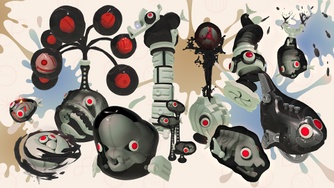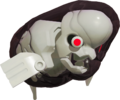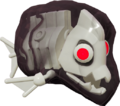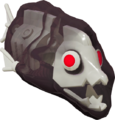Jelleton
The Jelletons are enemies encountered within the Spire of Order's floors in Splatoon 3: Side Order. They are artificial constructs created by the Overlorder to drive intruders out of the Spire. They were originally designed by Marina to be staff for the Spire and looked "cuter" until Overlorder took over and changed their purpose.
Appearance
The Jelletons are mechanical-looking enemies that appear as skeletal sea creatures encased in transparent black gelatin save for their tails, as well as their fins in the case of the larger ones. They are entirely white and have red and white eyes popping out of their sockets.
These enemies attack by lunging directly at Agent 8. Swarming Languendos can manipulate their height via their gelatinous components.
Types
In order of the Jelleton Field Guide from left to right:
Regular
 Swarming Languendo
Swarming Languendo Marching Andante
Marching Andante Battering Lento
Battering Lento Portal
Portal Drizzling Capriccioso
Drizzling Capriccioso Panicking Alla Mambo
Panicking Alla Mambo Whirling Accelerando
Whirling Accelerando Springing Spiccato
Springing Spiccato Gushing Trionfale
Gushing Trionfale Spawning Accordo
Spawning Accordo Homing Arpeggio
Homing Arpeggio Towering Nobilmente
Towering Nobilmente
Bosses
Quotes
| “ | These mysterious enemies pursue Agent 8 relentlessly in Wave 2 of the #Splatoon3: Expansion Pass, Side Order. Are they lifeforms, or machines? Whatever they are, they seem to be gearing up for something… | ” |
— @NintendoEurope on Twitter[1]
| ||
| “ | This just in from SRL Oppo Research: some fishy foes are all over the Spire of Order. They look like animated fish bones—biological or mechanical, we have no idea. All of them seem to act in harmony toward the same goal, but alas, that goal is to relentlessly harass Agent 8. | ” |
— @SplatoonNA on Twitter [2]
| ||
Gallery
3D artwork
-
A Battering Lento
-
A Marching Andante
-
A Marching Andante seen from another angle
-
A Swarming Languendo
-
A Swarming Languendo seen from another angle
-
Several Jelletons of different sizes
-
Jelleton Wallpaper From SplatNet 3
2D artwork
-
Black and white art of a Marching Andante
-
Sketch of a Battering Lento
-
Concept art of Marching Andante from a Famitsu interview
-
Concept art for the Towering Nobilmente
-
Swarming Languendo Concept art
-
More concept art for the Towering Nobilmente
-
Concept art for the Panicking Alla Mambo
Promotional screenshots
Gameplay
-
Agent 8 in combat with several types of Jelletons.
-
-
-
-
-
-
Agent 8 using the Pearl Drone to escape a horde of Jelletons.
-
-
Agent 8 pursuing a Panicking Alla Mambo.
-
Agent 8 attacking several Swarming Languendo and a Springing Spiccato with an Order Roller.
Website graphics
-
Several Jelletons being targeted by Agent 8's Killer Wail 5.1.
Trailer screenshots
-
A Towering Nobilmente.
-
A Panicking Alla Mambo.
-
A Gushing Trionfale.
-
Two Drizzling Capriccioso.
Trivia
- Many of the Jelletons resemble sea animals that play a significant role in bioerosion, a phenomenon that is known to cause the destruction of coral.
- Jelletons are the first enemy species in the Splatoon series' story campaigns to not be Octarian or a variant (sanitized and fuzzy) of them.
- However, they share similarities with Salmonids, as most of them are based on fish and they attack the player continuously instead of being stationary until provoked. The three basic types are similar to the Lesser Salmonids, namely Smallfry, Chums and Cohocks.
- The Panicking Alla Mambo are comparable to Goldies, being similarly shiny, having higher HP and are only seen is specific events (Goldies in Goldie Seeking & Glowflies and the Panicking Alla Mambo in its specific mission). They also behave like Tentakooks with how they leave Splat Bombs after a certain point while running away from Agent 8.
- Towering Nobilmentes are similar to both Octosnipers in their attack pattern, and Stingers in that they appear seated on tall towers that the player can knock away piece by piece.
- However, they share similarities with Salmonids, as most of them are based on fish and they attack the player continuously instead of being stationary until provoked. The three basic types are similar to the Lesser Salmonids, namely Smallfry, Chums and Cohocks.
- Defeating enough Jelletons of a specific variant will give players splashtag titles of their names, bosses included, once viewed in the Jelleton Field Guide. Those that have the titles unlocked will have their light gray entry be darkened in hue.
- While they appear at first to be made of bone, the background of Intensifying-Harmony.Floor implies that they're actually supposed to be plastic objects broken from injection-molded frames. This explains certain design elements of them, like their fins often having doll-like ball-joints, and the presence of conspicuous circles on parts of their bodies.
- During the battle with Overlorder, it may shoot several consecutive Reefsliders that closely resemble Jelletons, having a gelatin body and a visible skeleton inside.
- In the Lights Out Danger Effect, the Jelletons' bones give a faint, green glow, resembling phosphorescent material.
Etymology
"Jelleton" is a portmanteau of "jelly" and "skeleton", as well as a play on "gelatin" and possibly "tone."
Most of the names for individual Jelletons come from Italian words or phrases commonly used in music. According to an interview in Famitsu, this was done to reflect noted musician Marina creating the world they inhabit.
Names in other languages
| Language | Name | Meaning |
|---|---|---|
| スケルトーン Sukerutōn |
From "skeleton" and "tone", referencing the musical terms used in their names | |
| Drilgruwel | From dril (the jelly-like substance containing the eggs of fish and amphibians) and gruwel ("abomination") | |
| Squelécailles | From squelette ("skeleton") and écailles ("scales") | |
| Viskelloide | From Viskosität ("viscosity") and Skelett ("skeleton") | |
| Ossomolle (singular) Ossimolli (plural) |
Softbone Softbones | |
| Консервитор Konservitor |
Possibly from консервы konservy ("conserve", "canned food"), консервировать konservirovat' ("to conserve", "to preserve"), or консерватория konservatoriya ("conservatory", the Russian name of Memverse) | |
| Esquealeta | From esqueleto ("skeleton") and aleta ("fins") | |
| 骷髅鱼 Kūlóu yú |
Skeleton Fish |
References
|





























